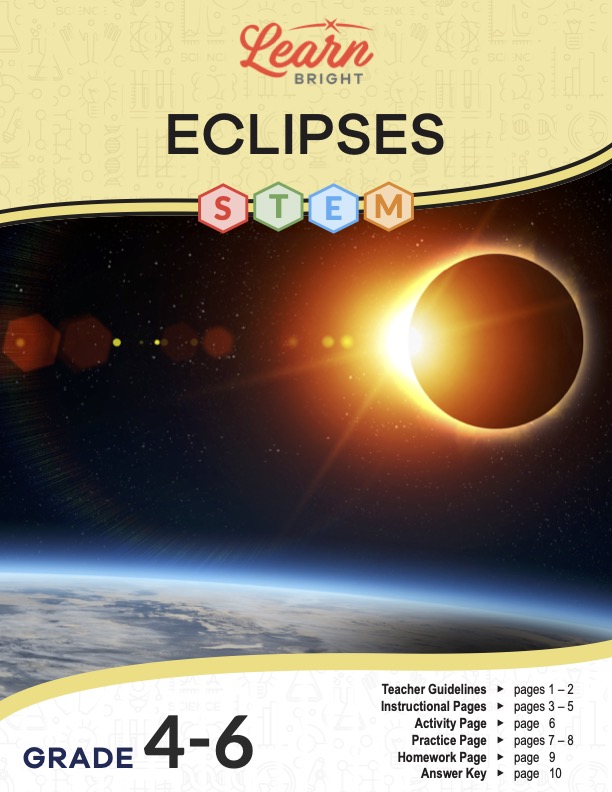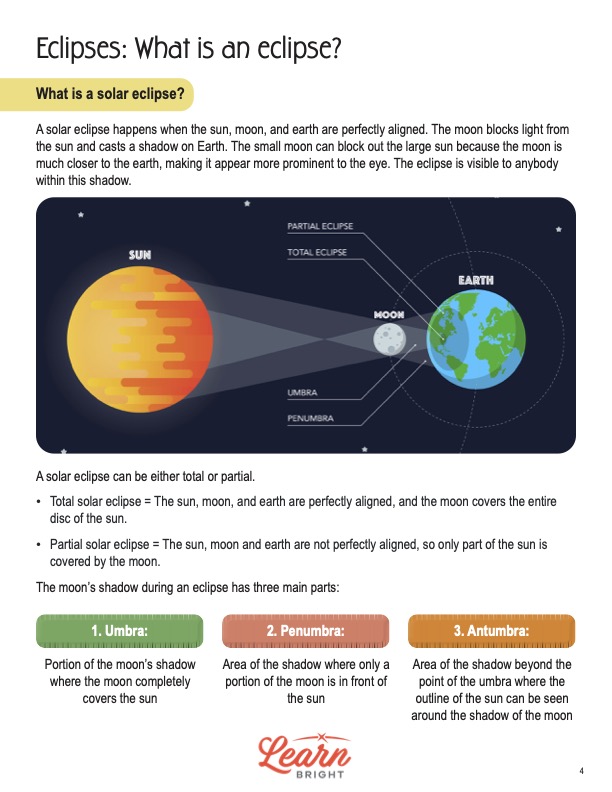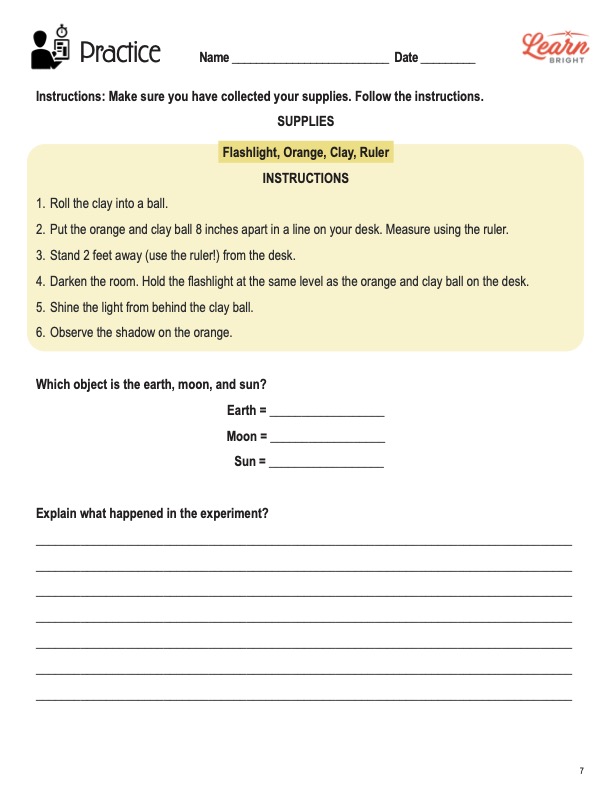Description
What our Eclipses STEM lesson plan includes
Lesson Objectives and Overview: Eclipses STEM introduces students to the difference between a solar and lunar eclipse. Students will learn how to define or explain what happens during one of these events. They will also be able to create a model to demonstrate how an eclipse would work. This lesson is for students in 4th grade, 5th grade, and 6th grade.
Classroom Procedure
Every lesson plan provides you with a classroom procedure page that outlines a step-by-step guide to follow. You do not have to follow the guide exactly. The guide helps you organize the lesson and details when to hand out worksheets. It also lists information in the yellow box that you might find useful. You will find the lesson objectives, state standards, and number of class sessions the lesson should take to complete in this area. In addition, it describes the supplies you will need as well as what and how you need to prepare beforehand. This lesson requires writing utensils, flashlights, rulers, clay, orange balls the size of an orange, Styrofoam balls in assorted sizes, and dowel rods or sticks that are between 18 and 24 inches long. You will also need a lamp without the shade for a demonstration.
Options for Lesson
The “Options for Lesson” section of the classroom procedure page outlines a number of suggestions for additional ideas or activities to incorporate into the lesson. One idea is to visit a local planetarium or science museum to watch a solar eclipse. Another idea is to show videos of actual eclipses that people have captured on camera. Students could create moon phases with Oreos. If possible, you could order eclipse glasses for your students to use during the next solar eclipse. As another option, you could create a classroom calendar that marks the phases of the moon and highlights the next lunar eclipse. One more suggestion is to throw an eclipse party in the classroom and create cereal box cameras obscura.
Teacher Notes
The teacher notes page provides an extra paragraph of information to help guide the lesson and remind you what to focus on. The blank lines on this page are available for you to write out thoughts and ideas you have as you prepare the lesson.
ECLIPSES STEM LESSON PLAN CONTENT PAGES
What Is an Eclipse?
The Eclipses STEM lesson plan contains a total of three pages of content. The lesson begins by defining eclipses as events during which one celestial body moves into the shadow of another. A celestial body is a moon or planet. There are two ways an eclipse can happen. The first is that one object moves in front of the other. The second is that one object casts a shadow over another object.
An eclipse requires three objects to align with one another. This is called sy+zy+gy. Students should remember that since we live on Earth, everything we observe is from our perspective. When it comes to an eclipse, then, the event is observed from a human’s perspective and position on the Earth at that time. Therefore, an eclipse looks much different from space or when standing on a different planet.
There are two main types of eclipses that people can observe on the Earth: lunar and solar. In a solar eclipse, the moon floats between the sun and the Earth. During a lunar eclipse, the Earth floats between the sun and the moon. The lesson then goes into more detail about each type, starting with solar eclipses.
Solar Eclipse
As mentioned, a solar eclipse happens when the sun, the moon, and the Earth align perfectly in that order. The moon blocks the light of the sun and casts a shadow onto the Earth’s surface. The small moon can block out the large sun because it is much closer to Earth. As a result, the moon looks more prominent to the eye. Anyone within the shadow of the moon can witness the eclipse.
A solar eclipse can be either total or partial. With a total solar eclipse, the three objects in space align perfectly, and the moon appears to cover the entire disc of the sun. With partial eclipses, the three objects do not align perfectly. Only a part of the sun appears blocked by the moon. (Regardless, one should never look directly at the sun during an eclipse without special glasses.)
The moon’s shadow during an eclipse has three main parts: umbra, penumbra, and antumbra. The umbra is the portion of the shadow where the moon completely covers the sun. Where only a portion of the moon is in front of the sun is the penumbra part. And the antumbra is the area beyond the point of the umbra where the outline of the sun is visible around the shadow of the moon.
Students will discover that where they are on the planet determines the type of eclipse they will see. They would witness a total eclipse if they lived in a place where the moon covers the sun entirely in the umbra. On the other hand, they would witness a partial eclipse if they lived somewhere covered by the penumbra. Finally, they might witness an annular solar eclipse if they lived somewhere where they can see the sun shine around the edges of the moon (antumbra).
Lunar Eclipse
A lunar eclipse happens when Earth comes between the sun and the moon, and the Earth shades either part or all of the moon. Lunar eclipses are visible to anyone on Earth for whom the moon is above the horizon. This makes lunar eclipses far more common than solar. In fact, they can occur about five times a year, and we don’t have to wear special glasses to watch!
Like solar eclipses, a lunar eclipse has two of the same shadow parts, umbra and penumbra. However, unlike with a solar eclipse, it is never totally dark. Instead, the moon will still reflect some of the sunlight. Sometimes the refracted light appears red in color. The content page provides diagrams throughout the lesson to help students visualize what’s happening with the two types of eclipses.
Key Terms
Here is a list of the vocabulary words students will learn in this lesson plan:
- Eclipse—when one celestial body moves into the shadow of another celestial body
- Solar eclipse—when the sun, moon, and Earth align directly and the moon blocks the light from the sun and casts a shadow on the Earth
- Umbra—the part of the moon’s shadow where the moon completely covers the sun
- Penumbra—the part of the moon’s shadow where only a portion of the moon is in front of the sun
- Antumbra—the part of the moon’s shadow where the outline of the sun is visible around the edges of the moon
- Lunar eclipse—when the sun, Earth, and moon align and the Earth blocks the light of the sun from reaching the moon
ECLIPSES STEM LESSON PLAN WORKSHEETS
The Eclipses STEM lesson plan includes three worksheets: an activity worksheet, a practice worksheet, and a homework assignment. Each one will help students solidify their grasp of the material they learned throughout the lesson. You can refer to the classroom procedure guidelines to know when to hand out each worksheet.
ECLIPSES STEM MODEL ACTIVITY WORKSHEET
Students will work either alone or with a partner for the activity. However, you may also do the activity as a class and participate in the experiment. First, place a styrofoam ball on top of a stick to represent the moon. In the center of the room, place a lamp without a shade, and turn it on. The lamp should be approximately the same height as the students. Turn off the other lights in the classroom and darken any areas where light might shine through so the room is as dark as possible.
Each student will take turns walking to the lamp in the middle of the room. The students will hold their sticks up at arm’s length and move them around their heads to model the rotation of the moon. They should move the ball until it blocks their view of the lamp to create a solar eclipse. Then they will put the ball on the opposite side of their head to make a lunar eclipse. After all the students finish, they will answer the two questions on the worksheet.
SIMULATION PRACTICE WORKSHEET
Using the supplies you provide, students will roll some clay into a ball. They will put the clay and the orange eight inches apart on their desk and will stand two feet away from the desk. You can turn off the lights to darken the room at this point. The students will then hold a flashlight at the same level as the orange and clay ball on the desk. They will shine the light on the clay ball and observe the shadow on the orange. Finally, they will respond to the prompts on the worksheet.
TIME TO DRAW HOMEWORK ASSIGNMENT
For the homework assignment, students will draw pictures to represent solar and lunar eclipses using two celestial bodies. The celestial bodies do not have to be planets, the sun, or the moon. They could be asteroids, rockets, or even alien space crafts!
Worksheet Answer Keys
There are answer keys for the practice and homework worksheets. The correct answers are in red to make it easy to compare to students’ work. Given the nature of some of the questions, students’ responses may vary. If you choose to administer the lesson pages to your students via PDF, you will need to save a new file that omits these pages. Otherwise, you can simply print out the applicable pages and keep these as reference for yourself when grading assignments.









